by Eliza Sterling

Worried about damaging your precious road running shoes by treading on rocky pathways, gloopy mud or through wild forests? Allow us to introduce you to your new running comrade – the trail running shoe. Whether you’re a leisurely jogger who prefers whispering trees to concrete jungles, or a high-intensity sprinter embarking on steep hills, trail runners can enhance your runs on non-paved terrain and reduce injury risks. These wonders aren’t just another excuse to add to your shoe rack. They’re carefully engineered to tackle the wildest terrains you dare to venture – think slippery inclines, loose gravel, or wet puddles.
No two trail shoes are crafted the same. Based on your preferences and type of terrain, you might opt for either lightweight models equipped for speedy feats or sturdy ones that offer stability and foot protection. Some versions specialize in ensuring secure grip on muddy trails, while others excel on harder terrains. To match the shoes to your trail calls, we’ve compiled a collection of trail shoes tailored for your needs.
Why You Need Trail Running Shoes
Not only can these shoes save a visit to the emergency room due to clumsily slipping or tripping, but their unique tread and deeper lugs ensure firm grip and stability on precarious surfaces. They come fitted with numerous technical features such as rock plates in the soles to soften the jolting impact of rocks underfoot, reinforced uppers, side walls, and toe bumpers to shield your feet from potential injuries.
What Sets Apart Trail Shoes?
Milly Voice, trail running aficionado and Salomon ambassador, lists grip, protection, fit and stability as the four key elements of trail shoes. Rock plates, reinforced toe regions, deep lugs for superior grip on unstable terrain are some of the shoes’ standout features. “A snug fit is crucial to ensure nimbleness on the trail, articulate joint movement and maintain excellent ground feel,” she points out. Factor in a 1cm gap between your toes and the shoe front to evade painful blisters and unsightly black toenails-and a stable, slightly heftier shoe helps maintain balance and reduces the risk of ankle sprains.
Choosing the Right Heel Drop
Heel drop refers to the height differential between the shoe’s front and back, which affects how your foot strikes the ground. Novice runners or those whose heels touch the ground first should opt for higher heel drops (more than 6mm), while experienced runners or those hitting the ground with the middle/front of their foot may prefer a smaller drop.
Trail Runners for Road Running?
Although trail running shoes may not offer as much ground contact when worn on the road due to their deep lugs and could wear out their soft rubber soles quicker, they can provide a firmer, responsive ride over hard concrete. However, brands are increasingly manufacturing ‘hybrid’ trail shoes designed for roads and uneven terrains. But we recommend sticking to your road running shoes for concrete terrains.
Trail Walkers for Trail Running?
Despite the possibility of running in trail walking shoes, it’s not advisable. They can cause quicker leg exhaustion due to their heavier weights and decrease your mileage. Since our feet strike the ground differently when we run compared to when we walk, running and walking shoes are constructed differently to accommodate stride, pace, and heel strike variations. It’s crucial to ensure running shoes fit for purpose to evade potential injuries.
Navigating the Terrain with Your New Trail Shoes
Based on the terrain you’re facing, your choice of trail shoes will differ:
- Hard-packed trails: A flexible, lightweight shoe with shorter lugs (2-4mm)
- Rocky surfaces: An outsole with more stability, rock plates underfoot, toe guards, and rugged uppers. ‘Sticky’ rubber outsoles enhance the grip
- Puddles and streams: Lightweight, well-ventilated shoes to allow water to drain out and cool your feet
- Uneven terrain: A shoe with a well-supported instep and upper for stability and balance
- Muddy trails: Deep (5-7mm), widely spaced lugs to prevent mud getting trapped in the treads
- Long-distance running: Good stability and ample cushioning
- A mix of tarmac and off-road: Hybrid shoes are softer and more flexible than a trail shoe, but have better grips than a road shoe
Ready to trail blaze your running game? Make sure to explore our picks for the best running shorts for women!
trail running shoes for women, best trail running shoes, foot protection, running shoe collection, grip and stability, running shoe fit, heel drop, trail shoes for roads, hybrid trail shoes, terrain running, choosing trail shoes
Leave a Reply